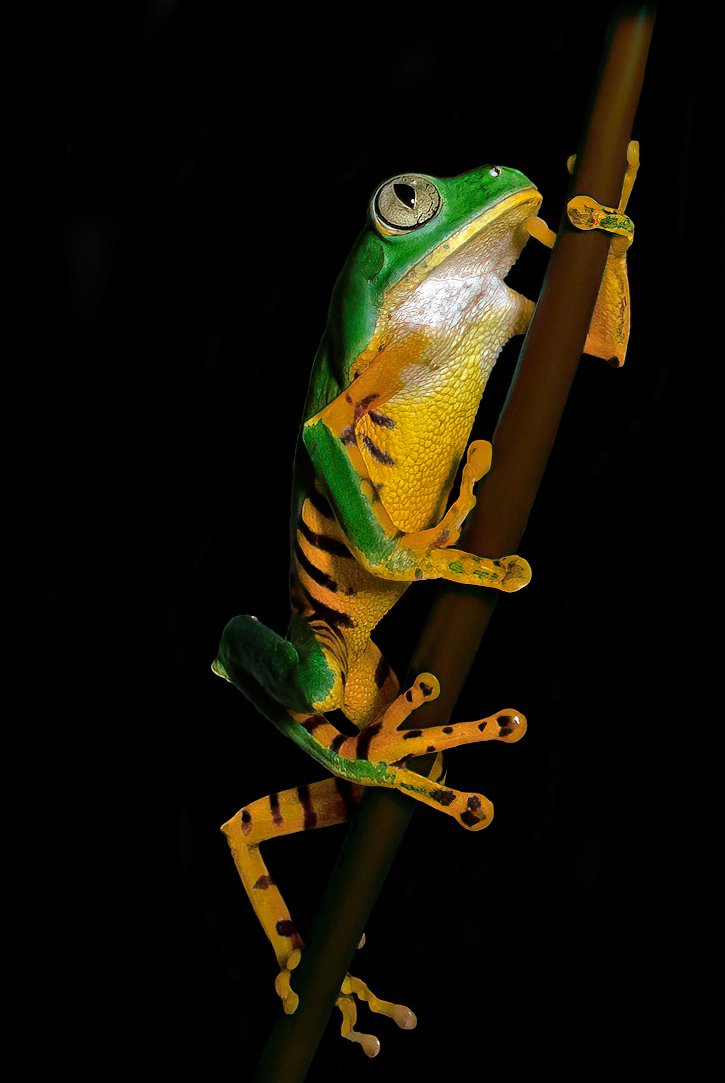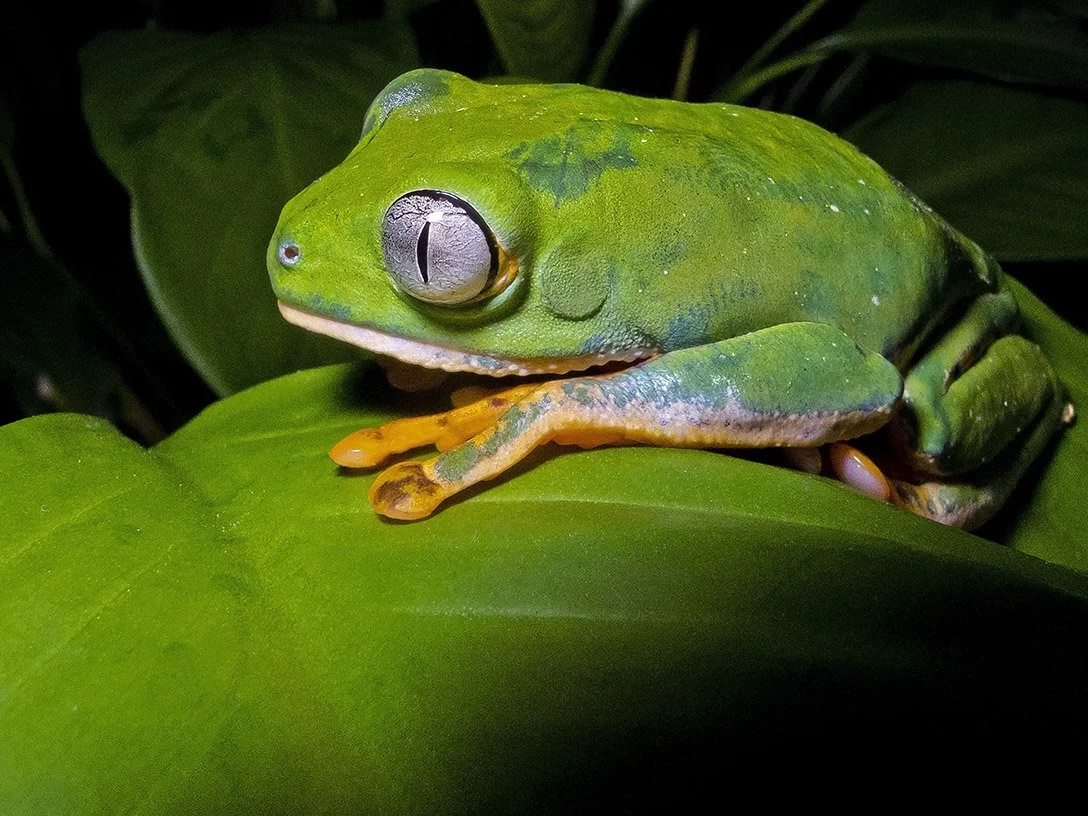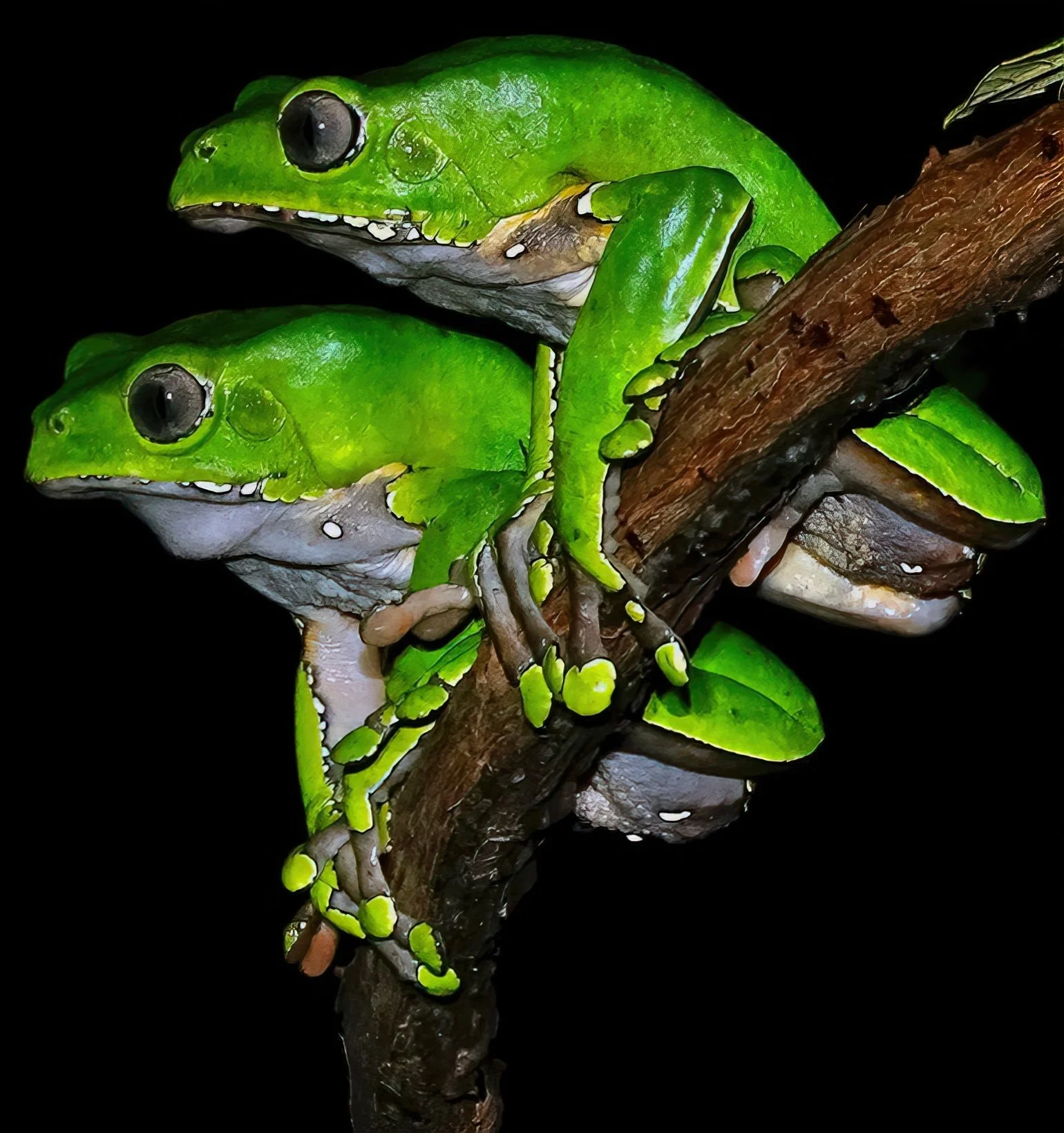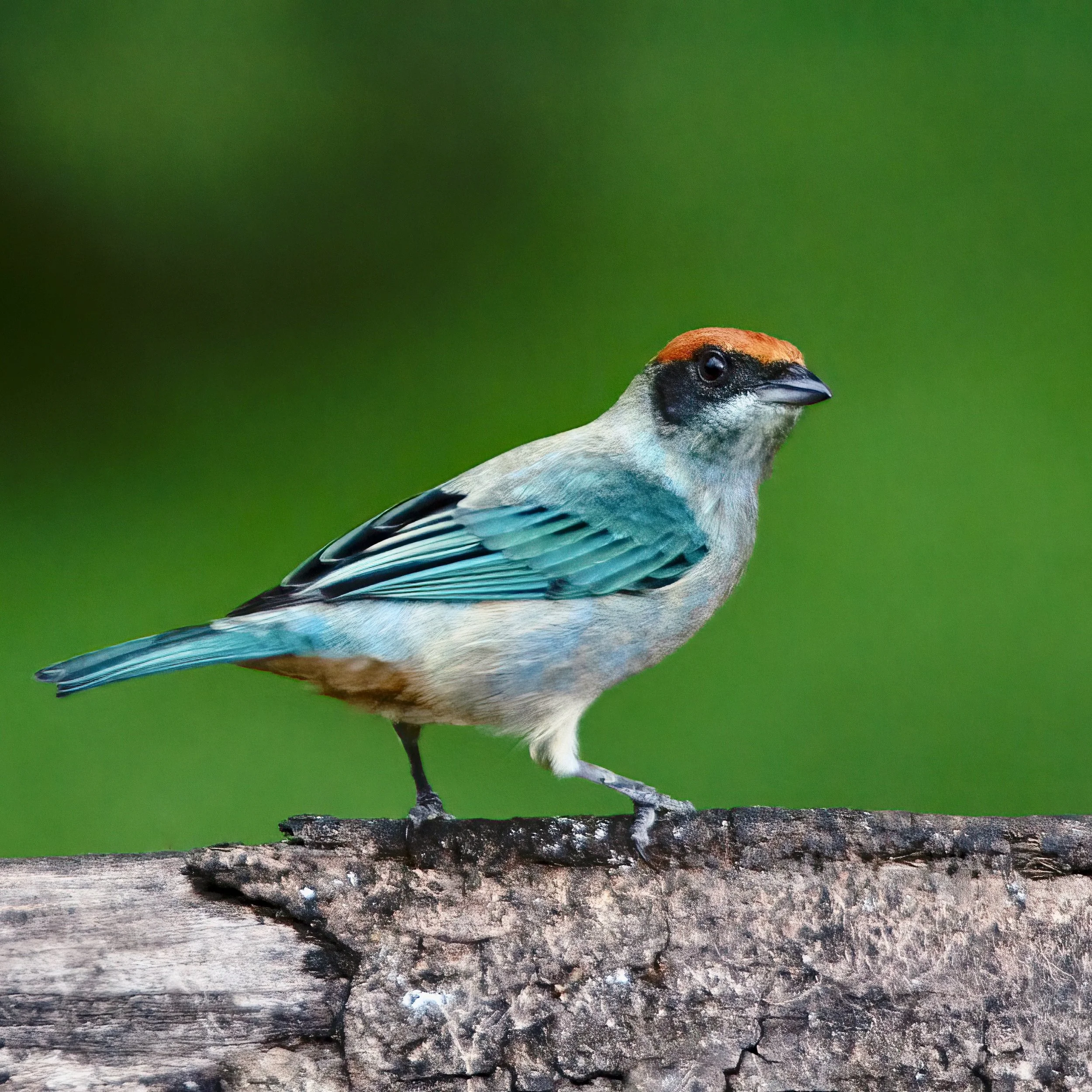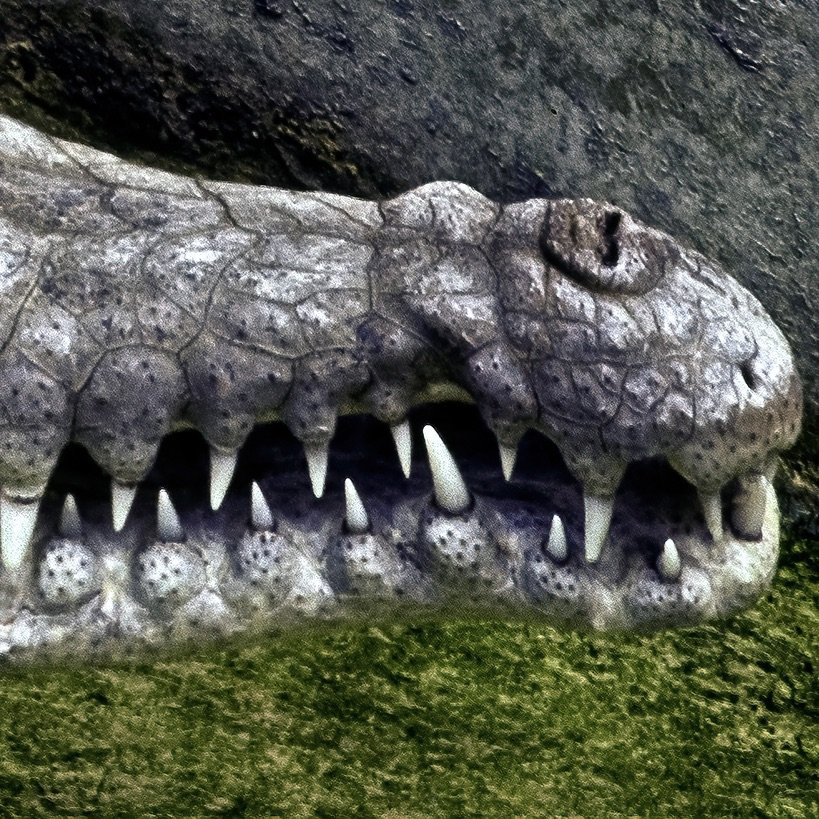Digital Solutions - A Picture with a Story
(Excerpted from the forthcoming book, “Primitive at Heart”, Part IV)
by William W. Lamar
The moment I emerged from my tent I saw the plastic bag on the ground - empty aside from a few leaves. Typically, after a night hunt the assorted polypropylene bags of amphibian and reptile specimens would each have been knotted and put into a safe place until morning when their occupants would have been organized, photographed, and released. Humidity is critical to tropical fauna, and the bags work nicely to conserve it. My grumbling mixed with growls quickly made everyone aware I was unhappy, which I was, considering that the escapee was not just any old frog. As veterans of countless nocturnal sorties, the crew are all trained to secure each bag as soon as we reach camp.
A Tiger-striped Monkey Frog, Callimedusa tomopterna, on the move. Not many frogs possess opposable digits but they provide a grasping ability that allows phyllomedusines to engage in acrobatics and trapeze artistry as they clamber about in the rainforest. Image: ©W. W. Lamar 2022
In Iquitos, Peru, wildlife tour companies traditionally hire city boys who are bilingual. Smart and dedicated, they quickly acquire the basic knowledge they need to lead a tour, but most of them are not truly of the forest. I have always taken the opposite approach, since language was not an issue because I could do the explaining to clients. My approach was to hire the best indigenous woodsmen around to make up my team. Between tours we frequently trekked for days across forest from one river to the next and back, and this was where the wild bunch proved invaluable. One of them, a phenomenally gifted Bóóraá Indian, was unsurpassed at spotting creatures in the forest. Seeing my consternation, he patiently went to work and presently called me over. He had located the escaped frog as it slept on a green leaf.
The missing frog was a phyllomedusine, member of a unique family of amphibians known for their lifestyle, their distinctive glandular secretions, and their physique. The name derives from the Greek language and means “leaf guardian,” where “phyllo” means leaf and “medusa” is guardian. Aptly called “National Geographic frogs,” their slow-motion walking and almost mammalian grasping ability make nearly every move a pose. About the only hurdle involved in obtaining compelling photographs of them is getting a phyllomedusine to stay awake for more than a few seconds during daylight. Phyllomedusines include the fabled Giant Monkey Frog (Phyllomedusa bicolor), source of the chic psychoactive substance, Kambô.
These frogs descend from the canopy only to breed. Life in the canopy, a breezy place where water — the elixir of life for amphibians — is at a premium. They have evolved a clever way of dealing with this shortage. Before retiring each morning, a phyllomedusine will slowly wipe itself all over with a lipid secretion that forms a waxy cuticle (Is this the original sunscreen?). Then the frog plasters itself to a leaf, pulling its extremities in close so as to reduce exposure . . . and there it remains — nearly invisible — throughout the day.
The emerald dorsum looks like some sort of delicate shagreen and at times it functions like a finger-printing pad, turning blue where touched. The sleeping frog was no exception (see photos) so once again I loudly asked who had left the bag opened. This, of course, was greeted with silence. I had an idea and was taking advantage of my exalted status. Not only was I the source of their paychecks, but also most regarded me with a measure of awe because I handled exotic artifacts (cameras, for example), roamed the forest by night, and picked up all manner of supposedly dreadful creatures. Rather than recognize that they lived beneath a cloud of old wives’ tales, they preferred to think I possessed special powers that inured me from harm. Amazonian Peru is a whole lot of things, but humor accentuates all of it. Indeed, it is nearly impossible to get through a day, let alone an hour, without hearing laughter.
Accordingly, I have put a lot of effort into playing pranks on my crew.
Feigning indignance, I let everyone know the frog displayed the fingerprint of the guilty party. One by one they filed over for a look. Meanwhile I proclaimed that I would be analyzing the print to see which of them was responsible. Of course, none of their digits were on record with me; a fact that never dawned on them. By now I had the entire camp in a state of anxiety, precisely the effect that I wanted. I carefully photographed the slumbering frog and made a protracted show of examining the images on the screen of my digital camera. The campsite, normally bustling with giggles amidst food preparation, was silent, almost frozen in time.
Busted? While I have no idea who left that bag untied, I must admit that the whorls on the fingerprint shown here on the frog’s upper back do resemble my own. Image: ©W. W. Lamar 2022
The men’s careers passed before their eyes.
When not using their opposable digits, phyllomedusines are quite capable of adhering to slick surfaces and negotiating all the hurdles in the canopy. Possessing hands and feet as proportionately large as catchers mitts certainly helps. Image: ©W. W. Lamar 2022
I rose and paused theatrically, staring at each one of them while channeling my best Charlton Heston as Moses just descended from Mount Sinai. When the discomfort was at its critical maximum, I announced that I now knew who was responsible and that it was . . .
…me!
The camp exploded with laughter and morale was, just as I had hoped, even better than before the frog incident. For a long time, I think I viewed myself as the venerated wise one, with naïve disciples surrounding me. The guys all held me up as The Great Kahuna, their fearless leader, and I bought into it. While I may have pulled my share of rabbits from hats over the years, impressing everyone, I eventually realized that they were actually the teachers, and I was the student. I do not refer to forest lore and bush craft, although I certainly learned a lot of that from them. By example, they showed me that life really cannot be lived without pain (something all of us understandably go to extremes to avoid), and that humor provides the antidote as well as the grace to get through it.
I also learned that deferred gratification, something I had been raised to cherish, wasn’t the way to deal with an Amazonian life filled with tough times and too frequent tragedies.
After all, sooner or later the river takes everything.
They know how to seize the moment, cry when sadness is afoot, and roar with laughter every time the opportunity arises.
“After all, sooner or later the river takes everything.”
Over the years my Anglo habits and beliefs, something I held sacred when I first arrived in Latin America, slowly gave way to their much wiser approach to living in the moment. As I look back over decades of unforgettable times in the rainforest, I see clearly that they imparted far more of their wisdom on me than I ever did on them…even if the details of fingerprinting may have eluded them.
A pair of Giant Monkey Frogs, Phyllomedusa bicolor, the source of Kambô and many a wild weekend in Silicon Valley these days. Image: ©W. W. Lamar 2022
All content ©Exotica Esoterica LLC® 2022 and ©William W. Lamar 2022
Follow us on:
